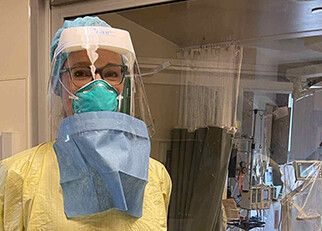Pathology residents step out from behind the microscope to help COVID patients

“I don't think anyone expected to have pathology residents on the ICU call sheet, us included,” says Dr. Irene Xie, Anatomical Pathology resident in the Department of Laboratory Medicine and Pathobiology. “I had been quite sheltered from the pandemic so it was surreal to step onto the ward and suddenly round with the team on twenty ventilated COVID patients”.
Irene wasn’t alone. Several pathology residents were redeployed to help during the pandemic, an experience that proved to be eye-opening and rewarding, not just for them, but for the clinical teams they worked with.
When the COVID pandemic hit Ontario in early 2020, Microbiology labs were under incredible pressure to adapt to the needs, and volume, of testing requirements. To do so, as described by Dr. Larissa Matukas, Head of Microbiology at St. Michael's Hospital of Unity Health Toronto, in Microbiology labs power pandemic response, pathology residents were redeployed to help. Processing the intake of COVID tests, these residents became part of a large team of healthcare and laboratory workers battling the pandemic.
As case numbers reduced in the summer, and microbiology labs adjusted to their new reality, there was less need for redeployment so the residents returned to their regular programs and hospital rotations.
But the pandemic wore on and frontline healthcare workers were at an increased threat of burnout as the Province entered a third wave.
Postgraduate Medical Education at the University of Toronto wanted to introduce a more sustainable way of supplementing the frontline staffing, so asked all departments to volunteer residents as part of their four-week rotation blocks. Residents from LMP were added to the list but weren’t initially called for service.
“I think they were reticent about taking pathology residents at first,” explains Paula Nixon, Postgraduate Education Officer in LMP, “They were worried they wouldn’t fit in, or cope with the challenges of a clinical service since there is a stereotype of Pathologists sitting in front of a microscope all day and not being involved in direct patient care.” However, when several LMP residents were redeployed, these fears were quickly alleviated.
Dr. Ariel Gershon was redeployed to Internal Medicine at Sunnybrook Hospital, prompting the Chief Medical resident to comment that he “had such a positive impact” and was “An absolute professional who went above and beyond to care for his patients.” He was later redeployed to the Emergency Medicine ward at Scarborough.
“At first I was nervous at the thought of going back to a clinical environment after being away for so long”, explains Ariel, “but I always felt supported by my team. I was happy to be making a difference in my patient's lives as well as making things easier for the internal medicine teams”.
Dr. Randy Van Ommeren was redeployed to General Internal Medicine at the Toronto Western Hospital and Dr. Boris Virine into General Internal Medicine at Mount Sinai Hospital.
When Drs Susan Armstrong and Irene Xie worked in Toronto Western Hospital ICU, they prompted the education coordinator to note “If I were to be completely honest there was some curiosity beforehand regarding how well pathology residents would integrate with the team, and we were all delighted that any trepidations we may have had were completely dispelled”.
Being on the frontlines of the pandemic was challenging for the residents, but a valuable experience.
“It was certainly challenging, not just because as a senior pathology resident it had been a while since I’ve provided direct patient care, but because of how sick the patients were. It’s hard knowing that a patient may not make it through a shift, even though we’re doing everything we can for them”, explains Susan. “Some of the conditions that these patients had are ones I’ve become accustomed to seeing from a pathology perspective. Seeing them from the patient's perspective gave me a new depth of understanding of these disease processes since I could see how the conditions are managed and the impact they have on the patient’s life. I think this will help make me a better Pathologist. “
“The medicine came back surprisingly quickly, and it was nice to work with residents from other specialties, which we don't often get to do in pathology,” adds Irene, “The critical care staff, anesthesiologists, fellows, respiratory therapists, and nurses were all so wonderful and taught us a lot. The ICU is an incredible place to deeply understand human physiology. It was sobering to see firsthand the prolonged mechanical ventilation that COVID patients undergo, the complications from that, and the deaths that still result despite maximal therapy”.
The high level of medical knowledge and training pathology residents have, was certainly an advantage as Ariel notes, “ I was even more thankful for my training in medical school and more appreciative of why pathology residents need to have a broad medical training”.
Most of all, the residents found it a great experience to work alongside the teams of trainees, physicians, and allied health workers in a different clinical environment than they were used to. “The last 16 months have had a real impact on the clinical staff at the Western and other hospitals, and it is a privilege to be able to contribute in a small way to help ease this burden”, says Randy.
Find out more
The LMP COVID-19 hub: find out how LMP is impacting how we understand, treat, and live with COVID-19



